by Melody Kendall

Let's look at them, their chosen prey and how these wonderful natural enemies help to keep the garden pest populations in check.
Convergent lady beetle:
A favorite of children of all ages, this wonderful beetle is not only cute, but a very voracious hunter of soft-bodied insects, insect eggs with their special favorite prey being aphids. Lady beetles go through four stages of development: egg, larva, pupa and adult. Females can lay several hundred eggs in their growing-season lifespan of about two months.
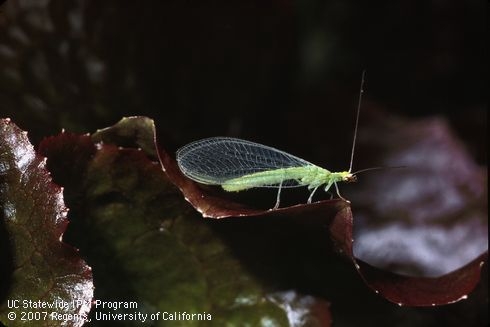
Devastating to any aphid population the convergent lady beetle young larvae suck out the insides of the aphids while the older larvae and adults will chew and swallow the entire insect. Each adult lady beetle can consume about 100 aphids a day.
These convergent lady beetles can be purchased in stores or on-line but keep in mind that once they have cleared your area of aphids, they will fly off to find more hunting grounds. https://www2.ipm.ucanr.edu/natural-enemies/convergent-lady-beetle/
Green lacewing:
These pretty insects have trim ¾ inch long usually bright green bodies with golden eyes all topped off with the lacy wings that give them their name. Moving through four stages of development, the lacewings usually require 4-6 weeks to mature from egg to adult. The adults feed on honeydew, nectar and yeasts and some, but not all, are predaceous. The larvae are the hunters as they pierce their prey and suck out the insides. The green lacewing consume mites and soft-bodied insects like aphids, caterpillars, lace bugs, leafhoppers, mealybugs, psyllids, scales and thrips so, wow, quite the hungry predators. These too can be purchased as eggs or adults.
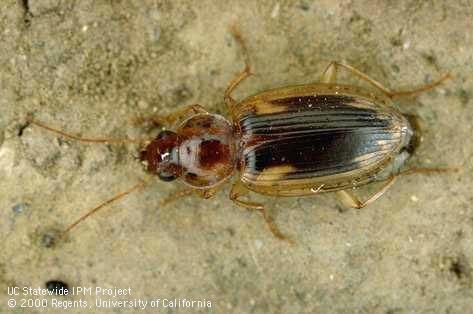
The adults are about ? -1 inch long with a mostly blackish or dark reddish hard shiny upper surface with prominent long legs and antennae. Predaceous ground beetles go through four stages of development that can take several months to more than a year depending on the food source and environment. Most take about a year to mature. When digging in the soil you might find the larvae which tend to lay straighter than the garden pests. Don't give the straight ones to the chickens. Hunting mostly during the night the adults are fast runners and rarely fly. During the day adults and larvae can be found in compost piles, leaf litter, mulch and under rocks, especially in moist locations. This is the long list of the predaceous ground beetle's prey: Caterpillars, root-feeding insects, soil-dwelling insects, and other ground-dwelling invertebrates including millipedes, slugs, and snails.
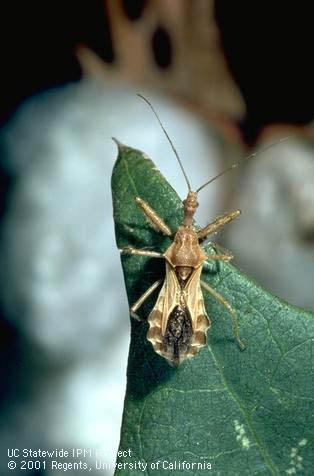
Depending on the species, the adult assassin bug is about ?-1/1/4 inches long and can be colors ranging from blackish, black and orange or a mix of all. They have long heads and bodies with long legs and narrow mouthparts. They can walk quickly when disturbed or when capturing prey and tend not to fly. Developing through three life stages the assassin bugs generally have one to two generations per season.
With their long needle-like mouthparts the assassin bugs feed on insects including caterpillars and larvae and nymphs of other true bugs. Impaling their victim with their tubular mouthparts, they inject venom and suck out the contents of the body. One species of assassin bug secretes a sticky substance to hold their prey in place. Being general predators they also feed on bees, lacewings, lady beetles and other beneficial species. Interestingly enough there is a species of assassin bugs that feeds on the blood of birds, mammals or reptiles.

Adult minute pirate bugs feature bulging eyes and an oblong oval somewhat flattened body. The 1/12 to ? inch long bug is colored mostly black, brown or purplish. Running through three stages of development that take about 3 weeks long during warm weather the pirate bugs can produce several generations in one year. Each growing season the predaceous minute pirate bugs are one of the first to begin feeding. Feeding through needle-like mouth parts both the larvae and adults suck the body fluids of their prey. Preferring spider mites and thrips they also feed on aphids, psyllids, small caterpillars, whiteflies and insect and mite eggs. They also feed on pollen and plant juices, but are not considered plant pests. Commercial greenhouses sometimes purchase and release the minute pirate bugs to control aphids in their greenhouses.

Dark brown to black with orange, red or yellow the adult soldier beetles have elongated bodies with bent down heads and segmented threadlike antennae. These adults are from 1/16 to 1 ? inches long, varying by species. Developing through 4 stages the adult soldier beetle lives a relatively short life and is mostly only observed in the spring through early summer months. The bulk of the soldier beetle's life cycle is as ground-dwelling larvae which can live 1-3 years. There are usually 1 or 2 generations of soldier beetles per year. The ground dwelling larvae are mainly predators of eggs, larvae and pupae of various arthropods, though some species feed on seeds and fleshy roots, but are not considered pests. Some species of adult soldier beetles feed on honeydew, nectar and pollen while others are predaceous, preying on aphids and other plant-sucking insects. The adults appear during the day and can be observed on leaves infested with aphids or other honeydew-secreting insects. The adult soldier beetle will drop from their perches like they are dead when disturbed. Their bright colors alert predators that they are distasteful as the larvae, pupae and adults alike excrete noxious, defensive chemicals from specialized abdominal glands.
https://www2.ipm.ucanr.edu/natural-enemies/soldier-beetles/
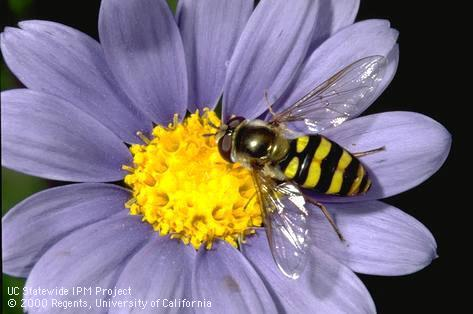
Spiders have a “yikes” factor, but consider spiders are beneficial because of all the pest insects they feed on. Spiders seen out in the open during the day are unlikely to bite and are just going about their business of pest patrol. The ones to worry about are usually hiding and not visible.
California has few dangerous spiders.
http://ipm.ucanr.edu/QT/commongardenspiderscard.html
Syrphids:
Adult syrphids or flower flies or hoverflies are slender flies ? to 1 inch long varying by species. The bodies of many of the adults are black with bands or strips of orange, yellow or white and resemble bees or wasps. Some species are brown, yellow, blue or a combination of all. Syrphids have four life cycles to maturity and the pupae require moisture and humidity to mature. Some species of Syrphids have five to seven generations per year while others have only one generation a year. In mild coastal climates they can be active all year. Most species of syrphid prey on aphids or mealybugs. Some feed on ants, caterpillars, froghoppers, psyllids, scales and other insects or mites. The larva can feed on upwards of 400 aphids before it pupates. 95% of syrphids are day active and are important pollinators. These adults are not predaceous as they consume honeydew, nectar, pollen and water.

Sixspotted thrips adults are about ? inch long with long hairlike fringes on their three dark spotted wings. These spots help distinguish this thrip from the other common California thrips species considered pests. The sixspotted thrips feeds on web spinning spider mites and other mites that don't spin webs. They feed on all stages of spider mites but prefer the immatures and do such a good job of clearing the spider mites out that few mites survive the feast.
https://www2.ipm.ucanr.edu/natural-enemies/sixspotted-thrips/
Parasitic wasps:
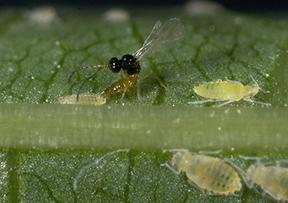
http://ipm.ucanr.edu/PMG/GARDEN/PLANTS/INVERT/wasp.html
These are the true heroes of the garden. Working diligently to reduce and control the invertebrate pest populations in our landscapes. To increase the effectiveness of resident natural enemies and any released natural enemies control the ant populations and reduce dust dispersal in your landscape. Grow flowering plants that provide nectar and pollen for adults and, most importantly, always research invertebrate pest control options. Use the right plant in the right place, declutter your garden and use barriers. Encourage natural predators in your gardens by avoiding the use of broad-spectrum pesticides. As a last resort, always research any pesticide before its use and find the least toxic pesticide that will do the job.
Next week we will wrap up this series with information on the IPM method of pest control and pesticides and their uses.
Napa Master Gardeners are available to answer garden questions by email: mastergardeners@countyofnapa.org. or phone at 707-253-4143. Volunteers will get back to you after they research answers to your questions.
Visit our website: napamg.ucanr.edu to find answers to all of your horticultural questions.
Information links: Natural Enemies and Biological Control
UC IPM Biological Control: http://ipm.ucanr.edu/PMG/menu.biocontrol.html
Biological Control and Natural Enemies of Invertebrates http://ipm.ucanr.edu/PMG/PESTNOTES/pn74140.html
Encouraging Beneficial Insects in Your Garden (Has a list of flowers that attract certain beneficials): pnw550.pdf (oregonstate.edu)
Attracting Beneficials to Your Garden: https://ucanr.edu/blogs/blogcore/postdetail.cfm?postnum=16607
Natural Enemies in Your Garden: A Homeowner's Guide, a 63 page downloadable booklet from MSU:E-2719.layout (msu.edu)